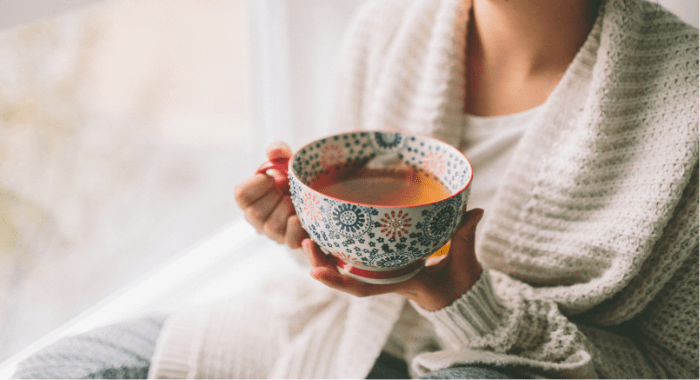
For many people, the shift from one season to the next can cause a drop in mood and mental clarity as serotonin and melatonin levels change. Some battle temporary “winter blues” while others are diagnosed with Seasonal Affective Disorder (SAD). If you notice a change in your mental and emotional state during specific times of year (even during spring and summer!), it’s likely you fall somewhere on this spectrum.
This is my 14th year to break out a few “natural” remedies that help me slide through late fall and winter until the first signs of spring start to peek out.
According to Mayo Clinic, if you’re struggling with any of the following, you might be experiencing seasonal depression/anxiety:
- Feeling depressed most of the day, nearly every day
- Losing interest in activities you once enjoyed
- Having low energy
- Having problems with sleeping
- Experiencing changes in your appetite or weight
- Feeling sluggish or agitated
- Having difficulty concentrating
- Feeling hopeless, worthless or guilty
- Having frequent thoughts of death or suicide
Signs to watch for in late fall/early winter:
- Oversleeping
- Appetite changes, especially a craving for foods high in carbohydrates
- Weight gain
- Tiredness or low energy
Signs to watch for in late spring/early summer
- Trouble sleeping (insomnia)
- Poor appetite
- Weight loss
- Agitation or anxiety
Here are 8 proven ways to fight seasonal depression and anxiety when you start to feel them creep in.
Hydrate
This is the most boring one on the list, but it’s also the most overlooked! Dehydration makes you feel sluggish – and if you’re waiting until you’re thirsty to drink, you’re already on your way. Aim for 2-3 liters of water throughout the day if you’re struggling with energy & clarity and don’t typically drink enough water. I make sure to drink two of these daily.
Exercise
People who exercise regularly typically have lower rates of depression in general, and some research shows that SAD can be avoided almost entirely by those who make exercise a priority. Whether you choose cardio & strength for the exertion, endorphins, and hormone balancing effects or walking. yoga, or Tai Chi for their calming effects, moving your body is key to holding seasonal depression at bay.
Vitamin D
Whether you get it being outdoors in the sun or via a supplement, Vitamin D is crucial as we move into the shortened winter days. Low Vitamin D levels are associated with an increase in SAD – so if you find yourself mostly indoors in the winter (midwesterners & northerners), consider adding some Vitamin D capsules to your Amazon cart.
An alternative to outdoor activity in the winter is a Light Therapy Lamp. I use mine for 20 minutes every morning at the recommendation of my doctor. I was skeptical at first, but it really helps!
A Calming Hobby
Many women turn to crafting as a source of calming, repetitive self-soothing! If you can push past the initial frustration and discomfort of being bad at something, crocheting, knitting, scrapbooking, embroidery, and sewing are all productive ways to spend your time that also help you regulate your nervous system (and nervous energy!).
Journaling
An offshoot of mindfulness, journaling is a way to practice gratitude and process/reflect on your days. Whether you use a guided workbook or a blank journal for your thoughts doesn’t really matter – the ritual is what’s important.
Natural Supplements
I’ve utilized a number of natural supplements for postpartum depression and anxiety over the years. My favorites include Joy-Filled from Happy Healthy Hippy, and Cyclng Frog CBD capsultes. Be sure to check with your doctor to make sure they are safe to take while pregnant/breastfeeding or with other medications.
Mindfulness
“Mindfulness” is kind of a buzzword right now – so what does it mean? Essentially, it’s using relaxation & breathing techniques to lower stress and anxiety levels. Spending just a few minutes a day with one of these apps can make a big difference!
Connect with Friends
An added challenge of winter Seasonal Affective Disorder is that it overlaps with the holidays – peak stress season for some and peak loneliness season for others. Loneliness is an epidemic in the United States, and it can strike anyone. Make sure that you’re connecting to Your People as often as you can – in-person or online. Call, text, Facetime – and be honest with them about your struggles. If they know they need to check on you, you’re more likely to feel needed and loved.
Therapy
Sometimes talking things through with friends and family isn’t enough – and that’s OK! Don’t be afraid to contact a professional therapist with your concerns. Regular therapy sessions (and sometimes medications) can help you process your experience with the extra guidance of an expert.
If you’re seeing signs of seasonal depression/anxiety, it’s unlikely that just one of these strategies will be the magic bullet. Experiment with several (or ALL) of them, and you’ll find this fall & winter much easier to handle!















